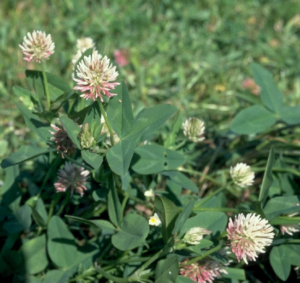Written by Blake Day, ’21.

You’ve probably seen these before, propagating your lawn, in-between the cracks of the sidewalk, maybe you’ve even pulled them out of your garden like a weed. Clovers, however, are surprisingly more useful than you might believe.

Many homeowners keep their lawns clean-cut with only grass. This requires lots of maintenance to keep its beauty; however, like in many other ecosystems, biodiversity is important for a healthy lawn to maintain its necessary nutrients. Often, to supplement our yards and gardens we use fertilizer to return key nutrients to the soil, such as nitrogen, phosphorus, and potassium.
Clovers, however, act as a local fertilizer and are a valuable resource for all plants in their vicinity. This comes from a unique feature of the legume family which clovers are part of. Legumes form a symbiotic relationship with a form of bacteria that fixes atmospheric nitrogen into ammonia.
While ammonia cannot be used by all plants, there are other bacteria in the soil that will turn ammonia into a more usable source of nitrogen through a process called nitrification. The truly difficult aspect of providing plants with nitrogen is this first step of nitrogen fixation which legumes handle so well. This can be seen in man-made fertilizers which typically use urea or ammonium (the acidic counterpart to ammonia).

The use of legumes as a replacement/supplement to fertilizers can be seen in agriculture. Many farmers practice crop rotation and use legumes (marketable ones such as peanuts and beans) to revitalize the soil. This is very important for farmers since they can achieve the same results as using fertilizers, but also still profit. Using a similar method, homeowners can achieve their desired healthy lawns while also saving money simply by allowing clovers to grow alongside their grass.
Environmental Implications:
Keeping clovers in your yard isn’t only financially beneficial; it can also help the environment. Large scale farming in Kentucky and other communities near tributaries of the Mississippi River has caused dead zones to be created in the Gulf of Mexico. These dead zones feature extremely low levels of oxygen that cannot support most sea creatures.
This strange result can be attributed to the water-soluble fertilizers used liberally by farmers. After the fertilizers are placed on the soil, rain can easily wash away the newly added nutrients. These nutrients end up in small streams that flow into bigger bodies of water which eventually flow into the Mississippi River and then out into the Gulf of Mexico. Once here, they can raise the nitrogen levels of the water slowly over time. This is a major issue due to a process called eutrophication.

Eutrophication features water acidification, low oxygen, and low biodiversity. It results from high levels of photosynthesizing organisms. When extra nutrients are added to water, more of these organisms can grow. This is good for the ecosystem since they provide oxygen and energy, but will quickly become harmful as they grow exponentially. Given time and enough nutrients, the organisms will create a layer on the surface of the water. This layer is so thick that light is blocked out for anything below, including the underside of the layer. Without light, these organisms will quickly die and decompose. Decomposition creates large quantities of CO2 , which acts as an acid when dissolved. The CO2 also replaces the oxygen in the water. This will kill most larger fish that require high amounts of oxygen and younger fish including eggs that are more susceptible to acidic conditions.
When fertilizers leach into small, still bodies of water, at the local level, the eutrophication process will devastate quickly. Many homeowners live near small bodies of waters such as lakes or ponds that they will then go to for recreational activities, so it is important that the use of fertilizers be minimized so the water can stay healthy. Keeping clovers in your yard is one easy way to reduce your personal fertilizer use. If you want to do even more good, try mowing less frequently to prevent the grass from dying and let the grass grow even longer right before winter so they’ll have healthier roots that will be less prone to freezing. Additionally, clovers are an important plant for pollinating insects. Without pollination, many other plants are able to re-propagate!


0 Comments